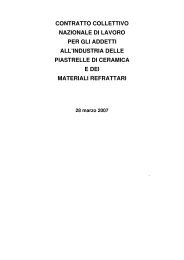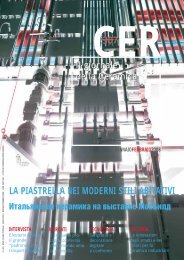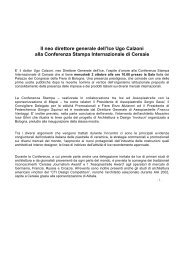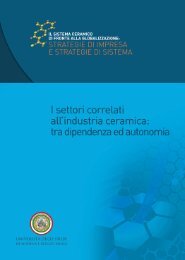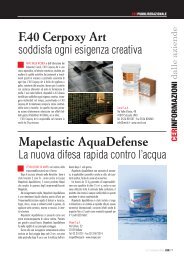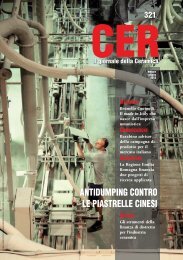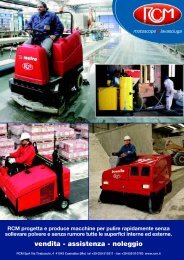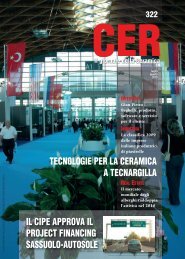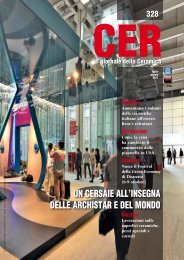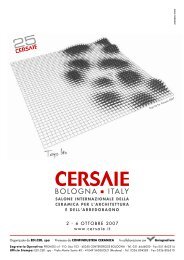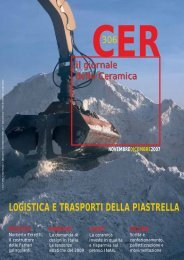Cer_318_completo xweb.pdf - Confindustria Ceramica
Cer_318_completo xweb.pdf - Confindustria Ceramica
Cer_318_completo xweb.pdf - Confindustria Ceramica
Create successful ePaper yourself
Turn your PDF publications into a flip-book with our unique Google optimized e-Paper software.
CERGALLERIA Essiccamento e cottura<br />
TCK<br />
Via L. Bandini 25, 41053 Maranello (MO)<br />
Tel 0536 944105 - Fax 0536 944108<br />
www.tck.it - info@tck.it<br />
RPC - sistema per il controllo della planarità<br />
L’eliminazione dei difetti dovuti alla concavità ed alla<br />
convessità del materiale ceramico, soprattutto nei grandi<br />
formati ed in particolare in quelli con lati molto lunghi,<br />
spesso si ottiene con la giusta angolazione dei flauti del<br />
raffreddamento rapido. Si tratta, però, di un’operazione<br />
non semplice, per questo a volte nemmeno effettuata.<br />
TCK ha trovato un’efficace soluzione per la riduzione dei<br />
difetti di planarità con RPC (Rotor Pipe Cooling), un<br />
sistema installato sui primi 3 o 4 flauti del raffreddamento<br />
rapido posti sopra e sotto il piano dei rulli. Attraverso un<br />
motore elettrico dotato di encoder e gestito da un PLC,<br />
RPC posiziona automaticamente i flauti nella giusta<br />
angolatura, memorizzata per ogni curva di cottura: in<br />
questo modo vengono gestiti automaticamente oltre un<br />
centinaio di differenti posizioni d’angolatura della<br />
soffiatura sui pezzi.<br />
RPC può funzionare sia automaticamente con l’ausilio di<br />
un planar di controllo, col quale tiene in memoria per ogni<br />
ricetta di cottura la giusta posizione della conformazione<br />
di soffiatura preimpostata, ma anche in modo manuale<br />
attraverso i comandi di selettori installati sul quadro di<br />
comando.<br />
Eliminando in modo significativo difetti quali la<br />
concavità e la convessità è evidente il<br />
vantaggio economico riscontrabile<br />
sulla produzione, ma anche sulle<br />
eventuali lavorazioni da effettuare<br />
in post cottura come<br />
levigatura, bisellatura e<br />
lappatura, dove vi è una<br />
riduzione sia dei tempi di<br />
lavorazione che un evidente<br />
risparmio sui componenti di<br />
usura.<br />
94 CER novembre/dicembre 2009<br />
RPC - flatness control system<br />
Faults caused by concave and convex ceramic materials<br />
can often be eliminated by setting the rapid cooling flutes<br />
at the proper angle, especially when working with large<br />
sizes and shapes that have very long sides. However, this<br />
is by no means simple and sometimes this step is skipped<br />
altogether.<br />
TCK designed the RPC system (Rotor Pipe Cooling) to<br />
provide an effective solution for reducing flatness defects.<br />
The RPC system is fitted on the first 3 or 4 rapid cooling<br />
flutes that are located above and below the roller<br />
conveyors. The RPC uses an electric motor complete with<br />
an encoder and PLC control to automatically position the<br />
flutes at the best angle, memorised for each firing curve.<br />
Over a hundred different blowing angle positions can be<br />
managed automatically.<br />
The RPC system operates automatically with the support of<br />
a control planar: this stores the best preset blowing<br />
configuration for each firing recipe in its memory.<br />
However, it can also run in manual mode using the control<br />
switches on the control panel.<br />
Production becomes more cost effective if faults such as<br />
convexity and concavity are largely eliminated, but there<br />
are also benefits for post-firing processes, such as<br />
polishing, chamfering and lapping, as less time is needed<br />
to do the job and there is less wear on components.



